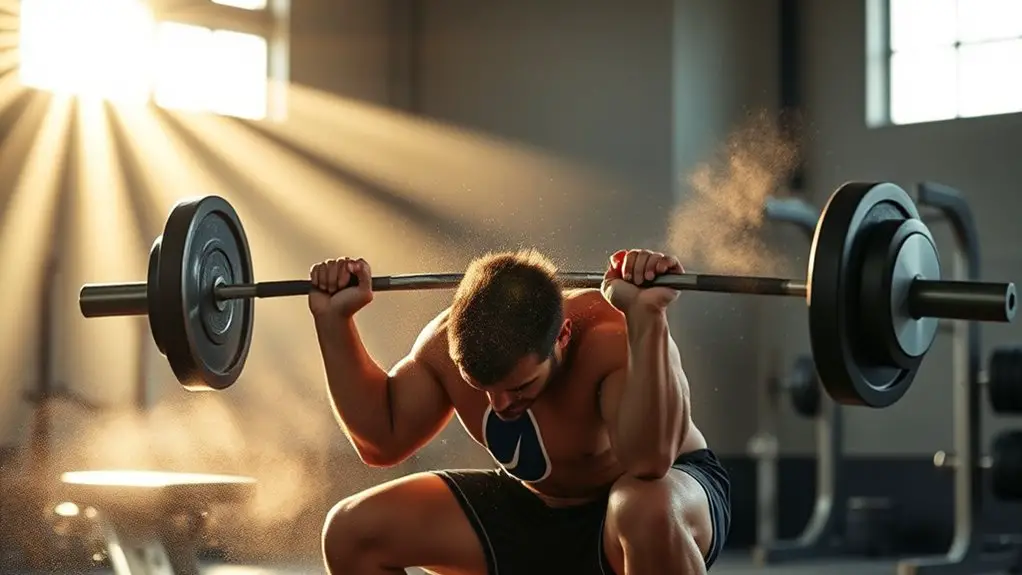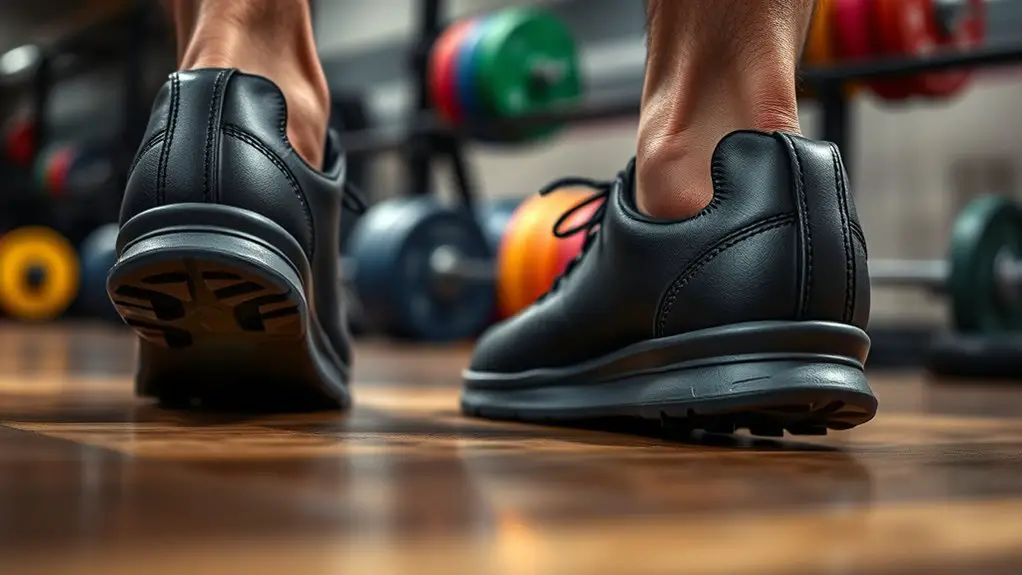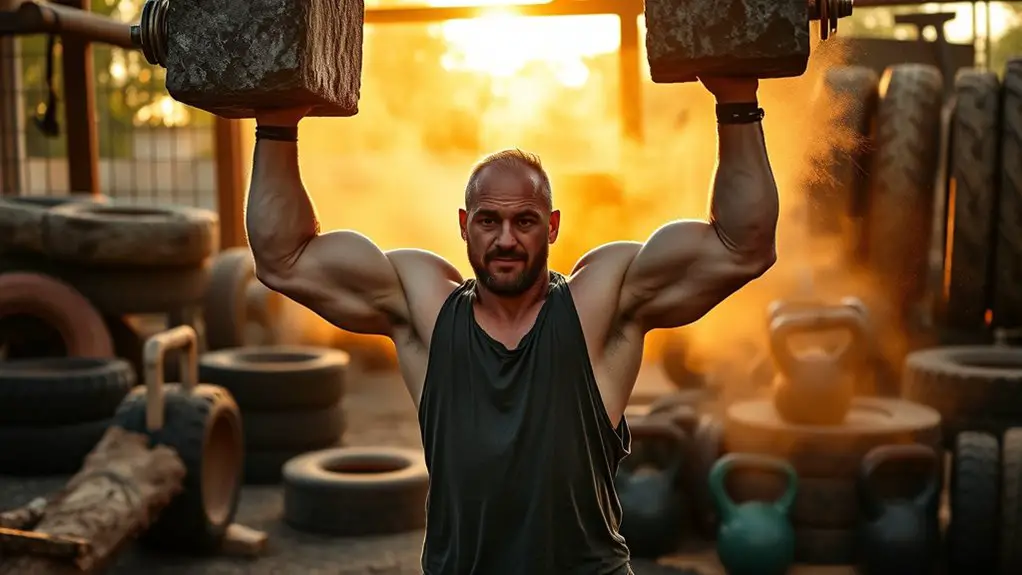To boost your athletic performance, focus on key compound lifts like squats, deadlifts, bench presses, overhead presses, and pull-ups. Squats build strength and stability; deadlifts develop power and target your posterior chain. The bench press enhances upper body strength, while the overhead press improves shoulder and core power. Pull-ups boost back strength and grip endurance. Each lift targets specific muscle groups, ensuring a well-rounded routine. Stick with us to discover more impactful training insights.
Squats: The Foundation of Strength
When it comes to building a solid foundation for athletic performance, squats stand out as an essential exercise. They're not just about brute strength; mastering squat technique can unleash your potential. You've got options with squat variations like front squats, overhead squats, and goblet squats, each targeting different muscle groups and improving your overall stability and power.
By incorporating these variations into your routine, you can keep your workouts fresh and engaging, which adds to that sense of freedom you crave. Focus on your form—keeping your chest up, knees aligned, and weight on your heels—ensures you maximize benefits while minimizing injury risk. Additionally, enhancing performance in various sports through squats will help you develop a comprehensive strength profile.
As you explore different squat variations, you'll discover what resonates with you, allowing for a personalized approach that fits your goals. Embrace the journey of strength and empowerment that squats can offer, and watch your athletic performance soar.
Deadlifts: Power and Posterior Chain Development
Building on the strength you develop through squats, deadlifts take your training to the next level by focusing on power and posterior chain development. By engaging your glutes, hamstrings, and lower back, deadlifts not only enhance your strength but also improve your athletic performance. Incorporating various deadlift variations—like sumo, Romanian, and trap bar—can keep your workouts fresh and target different muscle groups effectively.
These variations allow you to find the right fit for your body and goals, ensuring you maximize your gains. As you lift, you'll feel the freedom that comes with building a strong posterior chain, essential for explosive movements in sports and daily activities. Functional strength training embraces deadlifts in your routine will boost your power, giving you the edge you need to perform at your best. So, don't shy away from this vital lift; it's a game changer for your athletic journey.
Bench Press: Upper Body Strength and Stability
The bench press is one of the most effective exercises for developing upper body strength and stability. When you perform this compound lift, you engage multiple muscle groups, including your chest, shoulders, and triceps. This muscle activation not only builds raw strength but also enhances your overall athletic performance.
Incorporating the bench press into your routine is a smart choice for anyone looking to improve their stability training. As you press the weight, your core has to engage to maintain proper form, providing additional benefits.
Plus, the bench press allows for varied grips and angles, catering to your specific needs and goals. Whether you're pushing for heavier weights or perfecting your technique, you'll find freedom in the movement. Ultimately, mastering the bench press can lead to improved upper body power, giving you the advantage in various sports and physical activities. Embrace it, and you'll reveal new levels of performance. Furthermore, strength training is essential for injury prevention, allowing athletes to enjoy their activities without restrictions.
Overhead Press: Enhancing Shoulder and Core Power
Although many athletes focus on lower body strength, the overhead press is crucial for enhancing shoulder and core power. This lift not only builds shoulder stability but also engages your core, giving you the strength and balance needed for a variety of sports. When you press overhead, you're training your shoulders to stabilize under load, which translates to better performance in activities like throwing or jumping.
Moreover, the core engagement you get from the overhead press helps protect your spine and improves overall body control. You'll notice that stronger shoulders and a solid core can greatly enhance your athletic ability, allowing you to move freely and effectively. Incorporating rotator cuff strengthening exercises into your routine can elevate your training, fostering a sense of empowerment as you develop strength that carries over into your sport. So, don't skip this essential exercise; it's key to releasing your full athletic potential.
Pull-Ups: Building Back Strength and Grip Endurance
Incorporating pull-ups into your workout can greatly enhance your upper body strength, particularly your back and grip endurance. This compound lift not only targets your latissimus dorsi but also engages various supporting muscles, maximizing muscle activation throughout your upper body.
By experimenting with grip variations—like wide, close, or neutral grips—you can focus on different muscle groups, making each pull-up session uniquely challenging and effective. Whether you're aiming to master your bodyweight or increase resistance, these variations keep your workouts fresh and exciting.
Pull-ups also build your grip strength, essential for other lifts and athletic movements. As you progress, you'll notice improved performance in activities that require pulling or climbing, giving you that sense of freedom to explore your physical capabilities. Additionally, incorporating grip strength exercises into your routine can further enhance your performance in pull-ups and beyond. So, hang tight, get those pull-ups in, and watch your strength and endurance soar!
Frequently Asked Questions
How Often Should I Incorporate Compound Lifts Into My Training Routine?
Think of your training routine like a well-tuned engine; the right frequency keeps it running smoothly. Incorporating compound lifts two to three times a week is often recommended, allowing you to balance intensity and recovery. By using training periodization, you can adjust the frequency based on your goals, ensuring you don't feel restricted. It's all about finding that sweet spot where you can express your strength and enjoy the journey!
What Is the Best Warm-Up for Compound Lifts?
When you're gearing up for compound lifts, the best warm-up includes dynamic stretching and mobility drills. These help increase blood flow, improve flexibility, and prepare your muscles for the work ahead. Try movements like leg swings, arm circles, and hip openers to get your body ready. This way, you'll feel more liberated in your lifts, minimizing the risk of injury while maximizing your performance. So, don't skip this essential step!
Can I Perform Compound Lifts With Injuries?
You might feel torn, wanting to lift but held back by an injury. It's essential to listen to your body. Yes, you can perform compound lifts, but you'll need to implement injury modifications. Focus on lighter weights and proper form to avoid aggravating your injury. Consider rehabilitation strategies that allow you to maintain strength without causing harm. Freedom in your fitness journey can still exist, even with adjustments for your healing process.
How Do I Track Progress on Compound Lifts Effectively?
To track your progress on compound lifts effectively, start by establishing clear progress metrics like weight lifted, reps, and sets. Keeping a lifting journal can be incredibly helpful; jot down your workouts, feelings, and any changes. This way, you'll see patterns and improvements over time. Don't forget to celebrate small victories, as they lead to bigger ones. Embrace the journey, and you'll find freedom in your progress while refining your lifting skills.
What Nutrition Supports Optimal Performance in Compound Lifting?
You might think that any diet will do, but ideal performance in compound lifting requires careful attention to nutrition. Timing your protein intake around workouts can boost muscle recovery and growth. Incorporate diverse carbohydrate sources, like sweet potatoes and quinoa, to fuel your lifts and replenish glycogen stores. By choosing the right nutrients, you'll not only enhance your strength but also enjoy the freedom to push your limits in the gym.




